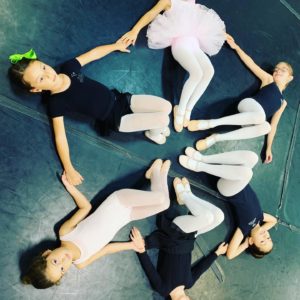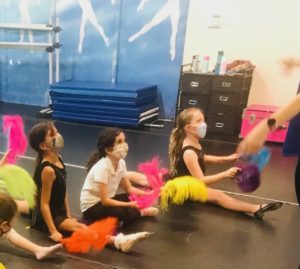Dance
Kindergarten
Ballet: At the Primary level, children understand and can safely execute ballet fundamentals. Through fun and engaging activities, we introduce and develop the foundational ballet building blocks, including proper turnout of legs, pointing feet, and body alignment. These elements prepare students for the continued study of ballet in the Ballet Program.
Children spend the class warming up, practicing exercises at the ballet barre, moving across the floor, stretching, and having time at the end of class to explore their own body movements.

Jazz : The jazz classes have a solid technical foundation with fun and fast-paced classes. They are an excellent way to develop rhythm, coordination, dexterity, and agility that carries over to other dance disciplines, academics, and athletics. Musicality and performance skills are taught through a series of exercises dance combinations.
Tap: A truly American art form, tap dance blends athleticism and artistry to deepen the dancer’s awareness of rhythm and musicality. Tap dance is a form of dance characterized by using the sound of one’s tap shoes hitting the floor as a percussive instrument. As such, it is also commonly considered to be a form of music. Tappers can create a variety of percussive rhythms with their feet by tapping, sliding, and clicking their tap shoes on the floor.
Character: Introduction to folk music and dance. Folk songs, rounds, spirituals, songs in other languages, and lullabies. Simple choreographies.
Dance Composition: Learn the basic elements of movement (time, space, weight, flow) and their choreographic applications explored through structured improvisation and short movements.
Build the range and capacity to move in a variety of ways. Perform basic locomotors skills (e.g., walk, run, gallop, jump, hop, and balance). Understand and respond to a wide range of opposites (e.g., high/low, forward/backward, wiggle/freeze)
First Grade
Ballet: Classes are designed for students who have studied the basics and are ready to concentrate on developing a broader ballet vocabulary, doing more barre and center work, and focusing on correct placement.
Children spend focused time at the ballet barre, exercise their balancing and jumping skills in the center, practice multi-step combinations traveling across the floor, and work on flexibility.

Jazz: These fun and energetic classes have the ability to showcase a dancer’s individual style and originality. The jazz classes have a solid technical foundation with fun and fast-paced classes. Through warm-ups and exercises, students gain strength, flexibility, endurance, and coordination.
Students will benefit from a sound working knowledge of learned sequences incorporating fall and release, rolling, and the body’s response to gravity.
Tap: This class brings dancer’s awareness of rhythm and musicality. Tappers practice percussive rhythms with their feet by tapping, sliding, and clicking their tap shoes on the floor. Learn simple choreographies.
Character: Folk dancing is a wonderful way to introduce young children to the world’s rich diversity, to teach the enjoyment of dance, music, and rhythm, and to begin a lifelong habit of the social enjoyment and physical activity of dancing. Learn new songs and choreographies.
Dance Composition: Demonstrate the ability to vary control and direct force/energy used in basic locomotors and axial movements (e.g., skip lightly, turn strongly, fall heavily). Perform short movement problems; emphasizing the element of space (e.g., shapes/lines, big/small, high/low).
Second Grade
Ballet: Students learn and practice the ballet technique. They work at the ballet barre, complete center exercises including an adagio, petit allegro, and stretching, and practice multi-step exercises that move across the floor, such as a grand allegro and turn combinations.
Special attention is given to aplomb (placement of the head and neck with stability in the cervical spine). Greater complexity in petit and grand allegro, pirouettes are introduced both en dedans and en dehors, increased use of the demi-pointe in the center.

Jazz: Classes focus on intermediate jazz sequences. It strongly encourages personal style as well as technique, and allows a student to explore many styles including contemporary, Broadway, lyrical, and more.
Tap: Students learn and practice tap technique choreographies. New exercises and choreographies.
Character: Folk dancing classes teach basic concepts of rhythm, repetition, sequencing, patterning, predictability, anticipation, musical cues, auditory discrimination, and counting. It is very multicultural—exposing children to dances from around the world, to dances representing different historical and social times, and showing children how all cultures, nations, and people are connected and interrelated
Dance Composition: Show a variety of combinations of basic locomotors skills (e.g., walk and run, gallop and jump, hop and skip, slide and roll). Show a variety of combinations of axial movements (e.g, swing and balanced shapes, turn and stretch, bend and twist). Perform short movement problems, emphasizing the element of time (e.g., varied tempos, rhythmic patterns, counting). Expand the ability to incorporate spatial concepts with movement problems.
